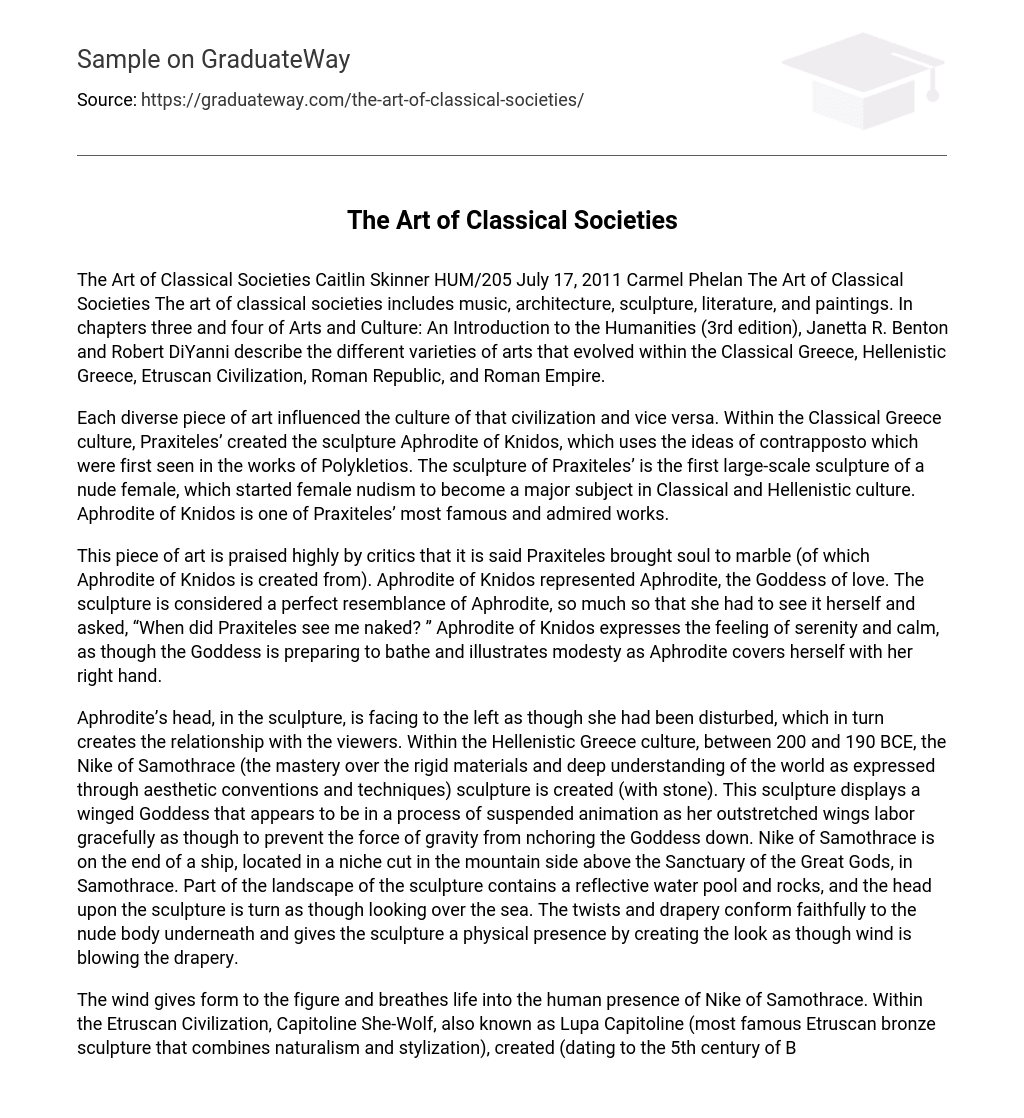The art of classical societies includes music, architecture, sculpture, literature, and paintings. In chapters three and four of Arts and Culture: An Introduction to the Humanities, Janetta R. Benton and Robert DiYanni describe the different varieties of arts that evolved within Classical Greece, Hellenistic Greece, Etruscan Civilization, the Roman Republic, and the Roman Empire.
Each diverse piece of art influenced the culture of that civilization and vice versa. Within the Classical Greece culture, Praxiteles’ created the sculpture Aphrodite of Knidos, which uses the ideas of contrapposto which were first seen in the works of Polykletios. The sculpture of Praxiteles’ is the first large-scale sculpture of a nude female, which started female nudism to become a major subject in Classical and Hellenistic culture. Aphrodite of Knidos is one of Praxiteles’ most famous and admired works.
This piece of art is praised highly by critics that it is said Praxiteles brought soul to marble. Aphrodite of Knidos represented Aphrodite, the Goddess of love. The sculpture is considered a perfect resemblance to Aphrodite, so much so that she had to see it herself and asked, “When did Praxiteles see me naked? ” Aphrodite of Knidos expresses the feeling of serenity and calm, as though the Goddess is preparing to bathe and illustrates modesty as Aphrodite covers herself with her right hand.
Aphrodite’s head, in the sculpture, is facing to the left as though she had been disturbed, which in turn creates a relationship with the viewers. Within the Hellenistic Greece culture, between 200 and 190 BCE, the Nike of Samothrace (the mastery over the rigid materials and deep understanding of the world as expressed through aesthetic conventions and techniques) sculpture is created (with stone). This sculpture displays a winged Goddess that appears to be in a process of suspended animation as her outstretched wings labor gracefully as though to prevent the force of gravity from anchoring the Goddess down. Nike of Samothrace is on the end of a ship, located in a niche cut in the mountainside above the Sanctuary of the Great Gods, in Samothrace. Part of the landscape of the sculpture contains a reflective water pool and rocks, and the head upon the sculpture is turned as though looking over the sea. The twists and drapery conform faithfully to the nude body underneath and give the sculpture a physical presence by creating the look as though the wind is blowing the drapery.
The wind gives form to the figure and breathes life into the human presence of Nike of Samothrace. Within the Etruscan Civilization, Capitoline She-Wolf, also known as Lupa Capitoline (the most famous Etruscan bronze sculpture that combines naturalism and stylization), was created. The legend of this sculpture is the twins, Romulus and Remus, were cast adrift on River Tiber and the wolf is raising them.
Romulus kills his brother Remus and establishes Roma Quadrate, located above the east shore of River Tiber. Romulus was the founder and also the first king of Rome, which makes the Capitoline She-Wolf a traditional icon of Ancient Rome. Within the Roman Republic, the Temple of Vesta is created with concrete and faced with brick or stone. This piece of architecture is a circular temple and had tall, slender Corinthian columns. Basically, this architecture is simple in plan and small in scale.
The Temple of Vesta is one of the most important sanctuaries of Rome built over whose cult the Vestal Virgins presided. Vesta, to whom the temple is dedicated, is the Goddess of the hearth and of fire, therefore this architecture features a circular cellar where the sacred hearth is and where the eternal fire burned. However, in AD 394, Theodosius closed the temple when paganism was banned in favor of Christianity. Within the Roman Empire, Vespasian and his son Titus constructed a public architecture called The Colosseum.
The Colosseum is a symbol of the strength, wealth, and power of the Roman Empire. The name of this theater was established because of its association with a colossal statue of Emperor Nero. Like Emperor Nero, many other emperors enjoyed the spectacles of the theater and would finance many of them. The amphitheater (type of building developed by the Romans with theaters housed at both ends and was circular or oval in plan) was different from the Greeks’ approach to architecture because the structure was not hidden, but rather emphasized.
The Colosseum is to accommodate over five thousand people, and each person is able to have a clear view of the arena to observe the entertainment. A tremendous number of amphitheaters are throughout Roman Empire because it was official policy in the state to provide entertainment for the public. The quality of the “entertainment” provided by The Colosseum soon turned into a political issue, but the displays became progressively more extravagant.





